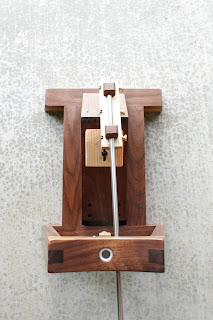Saturday, November 21, 2015
Chopsticks, Spatch'
I have plenty of wooden spoons, which is great, but I got tired of eating noodles and potatoes with my fingers. I thought some long skinny wooden finger substitutes would make eating more pleasant.
Here is the jig I made to help produce tapered hexagonal chopsticks. Not pictured is the hand plane. I start with split/riven sticks, cut to a square profile on the bandsaw. By using the three angled slots, I can work the squares down into hexagons.
Above, finished fir chopsticks.
Above are two things I whipped out on the lathe, a leather burnisher and handles for the shoe stitching wire. The wire breaks every 20 stitches or so due to cold work, so it's just loosely attached to the handles by twisting. The shape of the handles is to avoid tangling as much as possible.
Carved wooden spatula thing. The edge was flat before the wood dried, but now it's flat enough.
Thursday, November 5, 2015
More Spoons Etc.
Boot repair with very strong kevlar thread. This is a very slow process. Definitely spent longer repairing the boot than they did making it, maybe five hours per boot. Though, I doubt the people who made it were sipping tea in a quiet room while playing video games at the same time. After and before. Yellow gunge is waterproofing wax.
Fir tree cutout. Branches: Higgledy Piggledy
Drawknife envelope above.
And more spoons made from an alder log I found.
Sharpening Tool
I wanted to make my sharpening service more versatile, and to be able to put exact angles on nice things such as hair cutting scissors and expensive knives. I made this sharpening jig... a bit fancier than I set out to initially. It's made of walnut mostly.
The stone holder accepts 1" wide by 6" long stones. It only grips about 1/16", so I can get a lot of wear out of a 1/4" thick stone before replacing. Stones are relatively cheap, $6-14. I will probably make a handle for it someday, but for now it's not bad to hold the walnut block on top.
The two angle ranges on the "platen" range from nearly 0 degrees to about 70 degrees included on the front face. The front face is usually used for scissors and single bevel tools, the back face is for most knives, axes, etc.
Since the platen pivots, it's easy to put shims underneath it to work on a certain part of the bevel. With a knife for instance, a piece of cardstock is put beneath the platen to make sure only the tip of the edge is touched by a finer grit stone.
Cherry mechanical parts. PTFE bushing and hardened linear shaft. The smaller pivot slides on the unthreaded part of the cap screw... admittedly the weak point in this design but still far more than adequate. I'd probably use a shoulder screw if I made it for someone else. The screw which pinches the bushing can take all of the play out of the mechanism, not that it really needs to.
The pivot also has PTFE bushings, and rests on a ball bearing at the bottom. Very stiff and smooth.
Here it was in progress:
And in its native environment:
Subscribe to:
Posts (Atom)






























